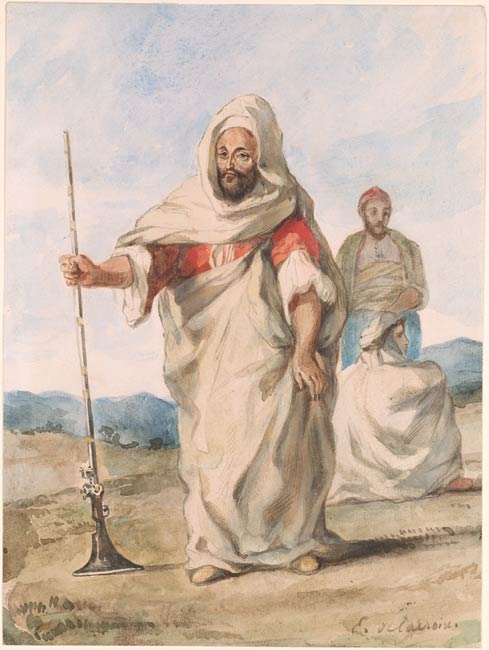
This independent watercolor was executed years after Delacroix's return from his 1832 trip to North Africa. Another watercolor of the same composition is signed and dated 1834 (location unknown; sold Paris, 30 June 1950, lot 2), suggesting that Delacroix produced several variants of some subjects that year. Around that time or a few years later, perhaps in 1838, he made a painted version of the same chieftain set in a landscape with a musket at his side (sale, Sotheby's, New York, 18 April 2008, lot 143, bought in). The chieftain depicted in both watercolors and the oil has tentatively been identified as Si Mokhtar el-Jamaï, the personal secretary to Moulay Abd er-Rahman. Er-Rahman was the Sultan of Morocco, a meeting with whom on behalf of the French government was the purpose of the embassy led by the Comte de Mornay, which Delacroix joined.
The setting is bare and mountainous. The chieftain wears pale gold slippers, a red caftan over a white djellabah, and a white burnouse gathered and tucked under his arm. Behind him, a young man in a white burnouse sits on the ground, and next to him stands a man in a red cap, short jacket, yellow belt, and loose blue trousers. In the painting, an agave plant has been added to the foreground, and the standing young man now wears a white burnoose over his clothing.
Signed in pen and brown ink at lower right, "E. Delacroix".
Goetz, Walter, 1867-1958, former owner.
Thaw, Eugene Victor, former owner.
Thaw, Clare, former owner.
Thaw Catalogue Raisonné, 2017, no. 99, repr.
The Thaw Collection : Master Drawings and Oil Sketches : Acquisitions since 1994. New York : Pierpont Morgan Library, 2002, no. 35.
